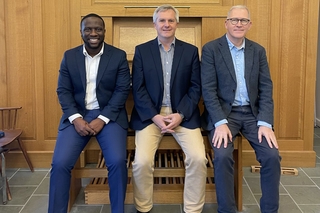By Markus Rathey, the Robert S. Tangeman Professor of Musicology and Theory at the Yale Institute of Sacred Music and Yale School of Music
What’s new in the world of organ music? During my sabbatical in the fall of 2022, I had the chance to delve into two captivating research projects centered around organ music from the nineteenth and twentieth centuries. One project explored the organ sonatas of French composer Alexandre Guilmant (1837-1911). While many of Guilmant’s compositions are fairly conservative, his organ sonatas take an experimental turn with cyclical forms that weave the different movements of the sonata into a cohesive whole. Cyclical forms were in vogue in symphonic music during his time, and Guilmant, alongside music theorist Vincent d’Indy, played a pivotal role in incorporating this essential formal principle into organ music. My research traced the concept of the idée cyclique in French music theory, highlighting how especially Guilmant’s fifth and sixth sonatas fully realized this principle (see my article “Alexandre Guilmant’s Organ Sonatas and the Search for a Cyclical Form” in The American Organist, October 2023).
On a grander scale, Hungarian composer György Ligeti (1923-2006) emerged as a true innovator. While most of us may have missed that 2023 was designated as ‘Ligeti Year’, his music is likely familiar to many through its inclusion in Stanley Kubrick’s film 2001: A Space Odyssey, which features excerpts from four of Ligeti’s compositions. In the realm of organ music, Ligeti’s forward-thinking ideas come to life in his organ works Volumina and two organ etudes. The composer explored ways to manipulate the organ’s sound, including playing all the keys simultaneously while engaging the wind supply. My own research focused on how Ligeti developed his groundbreaking ideas through close collaboration with several organists who inspired his compositional experiments (most of my work will be published in German, but I have also published a concise summary in my essay “György Ligeti’s Organ Works and the Spirit of Innovation Within Tradition” in Diapason, October 2023).
Engaging with these innovative approaches to organ music and performance raised the question that initiated this essay: What’s new in the world of organ music? My colleagues James O’Donnell and Nathaniel Gumbs have agreed to sit down with me to chat about this question. Both underscored that, despite its deep historical roots, the organ requires continual innovation and fresh ideas. As Nat Gumbs aptly put it, “We have to innovate if we don’t want the instrument to die!” But how can we achieve this?
